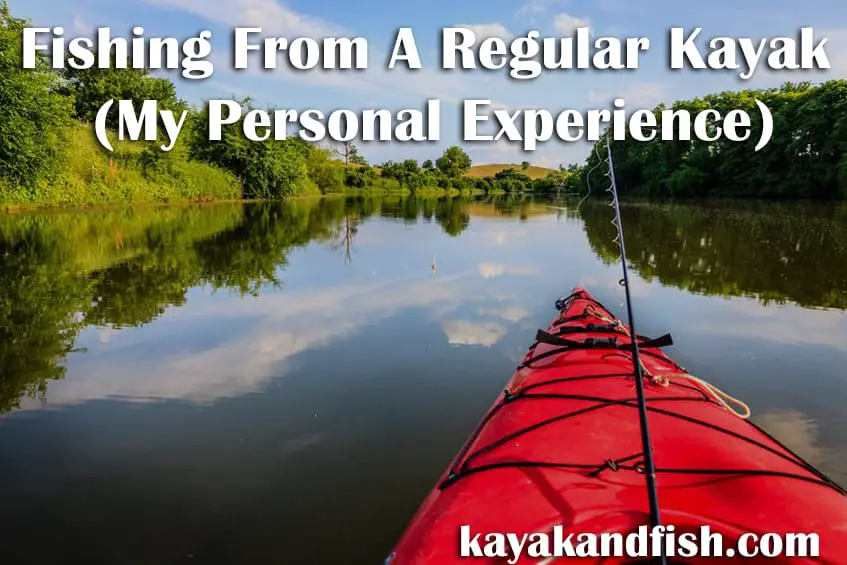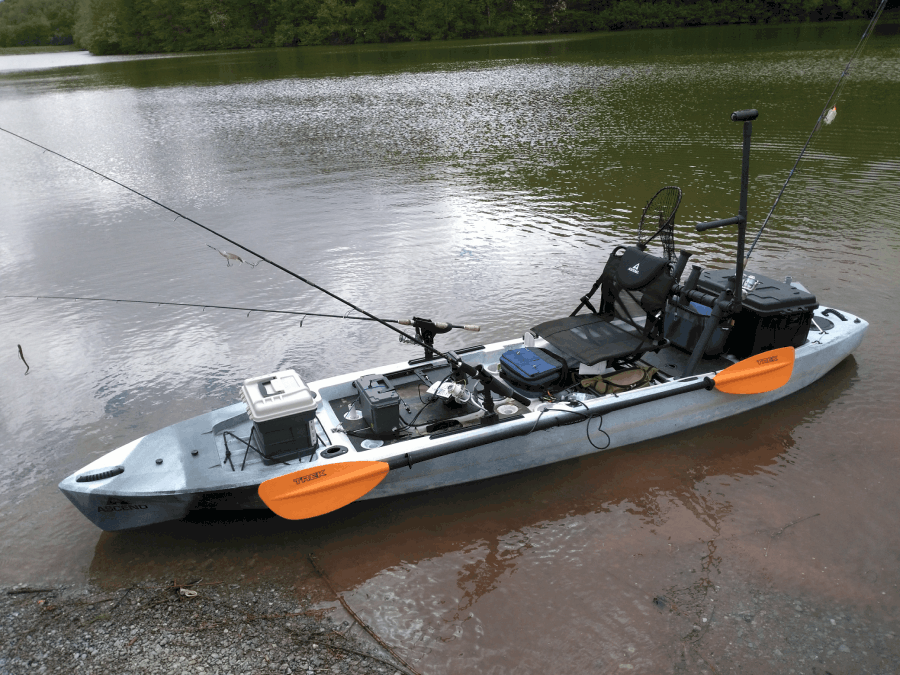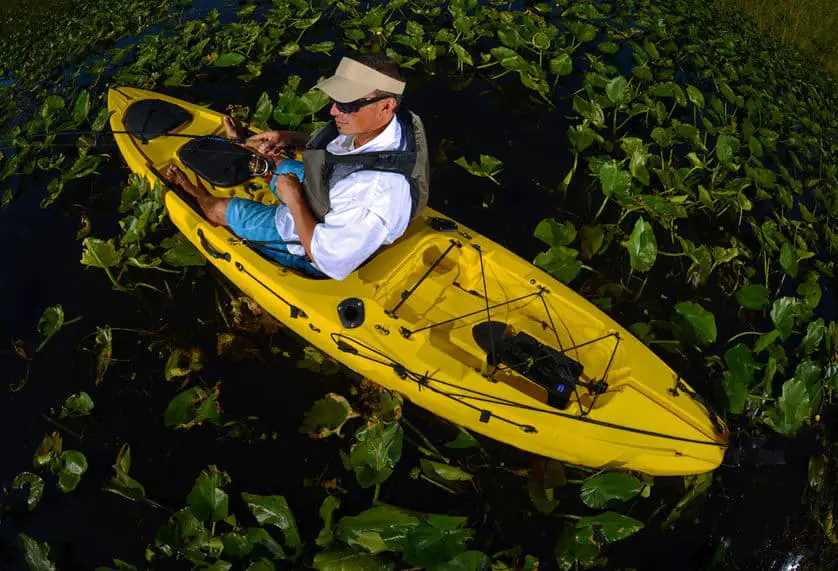
I had been bank fishing for my entire life up until the point that I decided I needed a boat or something to get me into better fishing spots so that I could improve as a fisherman. At the time kayaks were growing more popular for fishing and were just now starting to become widely available. I jumped in my truck and went and bought a kayak, but I didn’t learn about fishing kayaks beforehand.
I bought a cheap sit-in kayak from Walmart and learned very quickly that it was not the right kayak for the job.
Fishing from a touring or “regular” kayak is possible, but it is difficult. Touring kayaks simply do not have the same quality-of-life features that fishing kayaks come with out of the box. Regular kayaks lack rod holders, tackle storage, and other important features like fish finder support.
Let’s look at why a fishing kayak is a better option and cover some fishing tips for regular kayak users too. I also want to cover how you can make any kayak into a suitable fishing kayak.
Why You Should Purchase a Fishing Kayak Instead
Fishing kayaks, or sit-on-top kayaks more specifically, are relatively new types of kayaks compared to the traditional sit-in ones. Up until recently, someone would buy a kayak ride white water or tour down rivers or in the ocean. If you wanted to get out on the water as a fisherman, you had to buy a boat.
Fishing specialty kayaks are made with the angler in mind with essential features built-in.
What Makes a Fishing Kayak?
- Sit-on-top design
- Extremely stable
- Built-in rod holders
- Gear storage
- Comfortable seat
- Mounting spots for fish finders, a trolling motor, or other gear
- Strong Carry Handles are placed at port and stern
- Tons of legroom
- Easy to get on and off of
- Padded Deck for standing
- Scupper holes
- Cup Holders
Fishing kayaks are also built with more stability and track easier than their “basic” cousins. Touring kayaks are not built with anglers in mind and are made to just paddle around in the water for fun.

Fishing From a Regular Kayak
Like I said above, my first fishing kayak wasn’t a fishing kayak at all. It was a cheap, red, sit-in kayak from Walmart that bought on a whim. I fished with that kayak for over a year before I finally had enough and upgraded.
There are tons of sit-on-top touring kayaks on the market now days. If you happen to own or purchase on of these, you will have a far better time fishing from it than I did in my sit-in.
Here is what you can expect from trying to fish in a sit-in kayak and how to turn your sit-on-top kayak into a fishing worthy vessel.
Gear Storage/ Management
Gear storage and management is not easy in a normal touring kayak, that’s for sure. I made it work but taking a small backpack with 2 or 3 Plano boxes in it and sitting it in between my legs in the kayak. When I wasn’t digging through my tackle bag, I would push the bag into the cock pit to give my torso a little more room to breath and move around.
As far as my fishing rods went, I only brought one. I would sit the rod on top of the deck of the kayak with reel snagged inside the cockpit so that it wouldn’t fall off while I paddled. When I was done paddling to the next spot, I would lay the paddle across the cock pit and begin fishing.
Not efficient but it worked.
What to do When You Actually Catch Something
This was something I hadn’t thought of. Depending on what you’re fishing for, the rod length may matter to you. I like to fish with rods over seven foot but when you catch a nice bass in a regular sit-in touring kayak, it can be difficult to manage that catch properly.
First off, you should always bring a fish net. When you reel your catch in, bring it next to your kayak and net it, if you don’t you run the risk of losing the fish when you bring it out of the water by the line. Finding somewhere to keep the net is another issue because like I’ve mentioned before, gear storage is extremely limited.
The hard part starts when you get the fish out of the water. Trying to unhook a fighting fish while also making an effort to keep your rod and reel from flying into the water can be insanely difficult.
I always catch-and-release when I fish for bass but if you plan on keeping whatever it is that you’ve hooked, good luck because you don’t have a cooler. You could use a fish stringer but you’ll need to figure out how to rig it.
If you’re having trouble catching fish check out my guide: 11 Expert Tips for River Kayak Fishing (Catch 2x the Fish)
My Number One Issue
I am 6 foot 4 inches tall. Getting in and out of a sit-in kayak is not easy or graceful for someone my length. Fortunately, I have a slimmer build because if I was built like a normal tall person, I would not have ever gotten back out of that kayak.
Converting Your Regular Kayak Into a Suitable Fishing Kayak
There isn’t much you can do to make fishing in a sit-in touring kayak much easier, but if you have a sit-on-top touring kayak you can rig it up to be a decent fishing machine.

Gear Storage + Other Gadgets
The good thing about regular sit-on-top kayaks is that they have a decent amount of deck space. While most models are designed with kayak fishing crates and coolers in mind, you can strap one down to the back with relative ease. Kayak fishing crates are made specifically for fishing kayaks so you might want to stick with a simple, cheap, yet effective DIY milk crate kayak crate. Here’s a video showing you how to do that.
I like this video because this guy really embraces the DIY mentality and coverts his normal kayak into a cheap and effective fishing kayak.
Installing Rod Holders
Since regular kayaks don’t come with rod holders, we can install some relatively cheap. You don’t have to do this, you can just lay your pole down the length of your kayak while you paddle but if you plan on carrying more than one rod (as most serious fishermen do) then this is worth a look into.
I like these rod holders from Bass Pro Shops. They’re cheap and easy to install.
When trying to figure out where to install these, make sure that they will not interfere with paddling when they have a rod in them. You also want to make sure that the are you’re looking to mount has enough room inside the kayak so that it actually fits.
Some More Gear You Need
Let’s round off our conversion with the last few basic changes we need to make to the regular sit-on-top kayak to make it suitable for fishing.
You’ll want somewhere to store your paddle out of the way a cheap but effective tether to the side of the kayak is the way to go. Get that paddle out of your way so you can land more fish.
Depending on where you are fishing, you may want to pick up an anchor. I have an article that covers the different types of anchors and how they differ that you should check out: Why a Kayak Anchor is a Must-Have: With Examples
Whatever Gets You Out There Catching
At the end of the day, all that matters is that you are out of the water having fun and catching fish. If you don’t want to shell out the money for a real fishing kayak and just want to convert one you have laying around the house, that’s perfectly fine.
Don’t stress on the details of kayak fishing and just get out there and do it.

